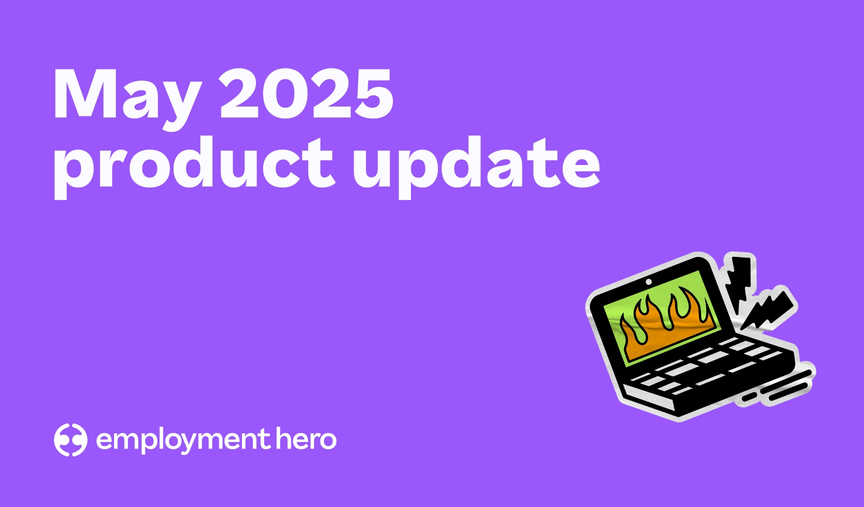November Hero Highlight news round-up
Here’s a round-up of November’s top HR & Payroll news for you – we’ve included links to each source article too.

Contents
What does the Autumn Statement mean for UK SMEs?
On Wednesday 22 November, Chancellor Jeremy Hunt gave a speech to the House of Commons unveiling the 2023 Autumn Statement. The statement was given in light of an ongoing cost-of-living crisis, high interest rates and inflation double that of the Bank of England’s target rate. A tough time for businesses. The plan promises to “back British business with 110 growth measures” which include tax reductions, wage increases and investments into businesses worth an estimated £20 billion a year. If you’re looking to understand how these plans could impact you, we’ve summarised the key points here.
Employees can look forward to reduced NI tax
Starting January 6, 2024, the rate is getting slashed from 12% to 10%. This change is going to affect around 27 million employees. Those earning about £35,000 a year, can expect to pocket an extra £450 annually because of this rate drop. But it’s not just employees who are benefitting. The self-employed are getting some love too. They’re waving goodbye to Class 2 National Insurance Contributions, and that’s going to help out roughly two million people. On average, self-employed individuals will save around £192 each year because of this move.
The national minimum wage increases
Starting April 2024, the National Living Wage, which is the minimum amount for workers aged 21 and over, is getting a significant boost of 9.8%. For a full-time worker, that increase could mean an extra £1,800 a year in their pockets. And it’s not just for the older workers—there are changes coming to the national minimum wage too, aimed at those under the age of 21.
- Employees aged 21 and over will now earn £11.44 a £1.02 increase (9.8%).
- Employees aged 18-20 will now earn £8.60 a £1.11 increase (14.8%).
- Employees aged under 18 £6.40 will now earn a £1.12 increase (21.2%).
- Apprentices will now earn £6.40 a £1.12 increase (21.2%).
Some relief on business rates
Business rates are taxes imposed on properties used for business purposes like offices, shops and warehouses.
The standard multiplier, affecting higher-value properties, will go up in line with inflation. But, if your property is valued at less than £50,999, you’re in luck—the small business multiplier won’t budge for another year.
For the retail, hospitality, and leisure sectors, there’s even better news: that 75% discount on business rates, which was bumped up from 50% a year back, is sticking around for another year, applying to properties valued up to £110,000.
This extension of relief is a welcome development for many of the 2.1 million businesses in the UK dealing with business rates.
An update on business investment
The Chancellor just laid out a bunch of plans to back up the UK’s most innovative industries, and it’s quite a list:
There’s £500 million set aside for the next couple of years to fund AI innovation centres. They’re really focused on helping folks get access to top-notch computing power.
How about £960 million? That’s going into the Green Industries Growth Accelerator. It’s aimed at supporting offshore wind, electric networks, nuclear, carbon capture, utilisation and storage, and hydrogen technologies.
A whopping £4.5 billion is earmarked to attract investments in strategic manufacturing sectors. This includes £2 billion for zero emission investments in the automotive sector, £975 million for aerospace and £520 million for life sciences.
But wait, there’s an expansion on the horizon for Investment Zones too. These zones offer low-tax and low-regulation environments to boost business growth. Now, these zones are in for a more extended period of financial incentives, stretching from five to ten years.
And that’s not all! Alongside the earlier announcement for West Yorkshire, three more Investment Zones are coming up in England: West Midlands, East Midlands and Greater Manchester. They’re expected to create around 65,000 new jobs. Also, Wales gets a second Investment Zone in Wrexham and Flintshire.
R&D tax relief
For those in the science and tech space, there’s reason to celebrate the revised Research and Development (R&D) tax relief scheme. Now, they’re making things easier. They’re merging this scheme with the Research and Development Expenditure Credit (RDEC) to simplify the process and, hopefully, get more businesses to claim it.
Oh, and they’re lowering the bar for qualification too! This means about 5,000 extra startups can hop on board and get relief as they grow their businesses.
No more late payments from government contracts
Late payments are a real headache for SMEs. So, the Chancellor decided to tackle this issue head-on.
If a company wants to snag those big government contracts, they’ll need to show that they pay their own bills within an average of 55 days. This rule kicks in starting April 2024. It’s not just the big companies bidding for these contracts that will be affected; it’ll also impact the many smaller businesses and subcontractors they work with to fulfil these contracts.
Looking for more insights?
If you’re on the hunt for more perspectives on how this could impact the UK SME space, why not take a look at some business leaders chiming in on their predicted impacts:
- Management Today – MT Asks: What do CEOs make of the 2023 Autumn Budget?
- Elite Business – Autumn statement: Business rates ‘freeze’ and tax cuts to boost SMEs
- The Executive Magazine – Comprehensive Overview Of The Autumn Statement
- South East Business Magazine – Autumn statement 2023: Reactions from the business community
- The Accountant Online – The accountancy profession reacts to the 2023 Autumn Statement
- Accounting Insights News – Jeremy Hunt Gives Accountants a Big To-Do List for Christmas
- International Accounting Bulletin – The accountancy profession reacts to the 2023 Autumn Statement
- Pensions Expert – Chancellor proposes ‘pots for life’ in major pension reforms
Are you missing out on the best applicants?

Ever felt like you’re losing out on great talent after a lengthy interview process? Well, you’re not alone. According to Eden Scott’s survey of 1,035 UK workers, more than half of candidates (52%) are hesitant to go through more than two interviews just to land a job.
Now, here’s the kicker: around a quarter (27%) are happy with three interviews, while a meagre 12% are up for four or more. That’s not a lot of wiggle room.
Patience wears thin quicker than you might think. On average, job hopefuls start losing interest if they don’t hear back within nine days after an interview. For those seasoned folks aged 45 and above, that interest wanes after just eight days.
Michelle Lownie, the big cheese at Eden Scott, gave a heads-up that businesses risk missing out on top talent due to long-winded and ineffective communication during interviews. In simpler terms: boring and slow processes mean losing your dream candidate to another, more efficient company.
So, how do you fix this? Michelle suggests streamlining your hiring game. Keep it swift, keep it interesting. No one’s got time to wait around, especially when other companies are vying for the same talent. But here’s the thing she emphasised: preparation is everything. Don’t start your recruitment drive at the last minute; that only leads to frustration for everyone involved. Plan ahead, get your strategy straight and avoid unnecessary bottlenecks. You don’t put the cart before the horse, so to speak.
And speaking of dragging things out, Nick Allwood from Macmillan Davies chimed in. He warned that lengthy interview processes can make candidates lose interest or find other gigs, leaving you back at square one.
What Nick stresses is crystal clear: keep the communication lines open. If decisions are made, give feedback. If there’s a delay, explain why.
Remember, it’s not just the candidates being scrutinised; they’re evaluating you too. So, use interviews wisely. Show off your company, highlight perks, make a killer first impression. After all, interviews are a two-way street.
Also try to focus on situational tasks, not just standard questions. This can reveal a lot more about a candidate’s skills and suitability early on. Plus, it keeps things interesting for everyone involved. Read more from People Management
A commitment to EDI could bring your business more revenue

Just last month, Harvard Business Review, in its article ‘What Makes an Inclusive Leader’, found that inclusivity is a powerful tool for attracting talent, keeping your team intact, and boosting creativity and success. Inclusive organisations are up to 73% more likely to score big on innovation revenue and around 70% more likely to explore new markets. They’re also up to 50% better at making smart decisions and up to 36% more profitable. Sounds good, right?
But here’s the real game-changer: leaders hold the key. They can create an environment where employees feel a sense of belonging and safety, making a whopping 70% difference in how employees experience their workplace. Plus, inclusive leaders witnessed a 17% hike in team performance, a 20% boost in decision-making quality and a remarkable 29% increase in team collaboration.
If inclusive leaders wield such incredible influence, it makes sense that traits they possess like humility, curiosity and empathy are seen as essential leadership skills. These aren’t just nice-to-haves; they’re critical for fostering belongingness and authenticity within your company.
Speaking to 40 outstanding inclusive leaders who won diversity, equity and inclusion awards or were nominated by their peers, Harvard Business Review found they shared five key behaviours that can make a company more inclusive.
- First up, inclusive leaders value authenticity over projecting a powerful image. They believe in creating an environment where people feel safe to express themselves and voice different opinions without fear of backlash. How? By being real, showing vulnerability, and encouraging curiosity among their teams. Forget the idea of always projecting a perfect image of leadership; it’s about being genuine and open about strengths and weaknesses.
- They aren’t afraid to shake up outdated rules. They challenge practices that exclude certain groups and replace them with inclusive ones. For instance, they tweak dress codes to be more inclusive of various cultures or challenge promotion criteria that unfairly disadvantage working mothers. They’re all about creating a level playing field for everyone.
- They’re perpetual learners. They understand that inclusivity isn’t a passive trait; it’s a skill that needs consistent practice. They embed diversity efforts into everyday processes, ensuring everyone is accountable. This includes diversifying candidate pools during recruitment, integrating inclusion into performance metrics and coaching managers on giving fair feedback.
- They ensure equal opportunities for all. These leaders recognise and address the unique needs of team members from diverse backgrounds. They provide extra support where necessary, ensuring fairness and understanding among all employees.
- Lastly, they believe inclusion is everyone’s responsibility, not just HR’s. They don’t limit diversity initiatives to a select few; instead, they integrate inclusivity into the core values of their organisations. This ensures that inclusivity becomes a natural part of the company culture, not just a programme on paper.
In conclusion, these inclusive practices aren’t just about being nice; they’re game-changers. They create vibrant workplaces where everyone thrives, leading to better products, collaboration, breakthroughs, and, ultimately, a bigger slice of success for the company. It’s time for SMEs to embrace inclusive leadership for a stronger, more successful future! Read more from the Harvard Business Review
If you’re having a rough time, you’re not alone

It’s been a tough year for businesses, and the numbers don’t lie. We’re looking at the highest rate of companies going under since the financial crisis back in 2009. Insolvencies have shot up by 10% in England and Wales compared to this time last year, and it’s not looking any rosier.
The count of companies in dire financial straits has surged dramatically, with a 25% increase in businesses facing critical distress. These are companies dealing with county court judgements of over £5,000, often a sign they’re heading towards closure.
The stats don’t paint a rosy picture either. Nearly 38,000 companies are now in critical financial distress, according to data analysed by Red Flag for Begbies Traynor. Julie Palmer from Begbies Traynor attributes this to higher inflation and borrowing costs, coupled with shaky consumer confidence and demand.
Construction firms are feeling the heat, especially with a staggering 46% increase in critical distress compared to just three months ago. Ceri Lee, director of a building works company, observed customers holding off on home improvements due to rising borrowing and material costs.
The fluctuating price of materials adds more pressure. Mr. Lee highlighted the soaring prices, mentioning that what cost £56 last year now goes for £129 each. This hike eats into profits, making pricing jobs a guessing game.
The Covid support lifelines, like furlough and loans, kept many companies afloat. But as those supports dwindle and inflation plus interest rates soar, they’re hitting hard. Business owners, like Betina Skrovo running bakery and coffee shops, are feeling the strain.
Betina expressed the challenges of paying back support while dealing with escalating fuel and electricity bills. She compared running a business now to climbing a mountain, where one misstep could mean a fall. Many business owners are feeling overwhelmed, seeking advice as they grapple with what feels like an impossible situation.
Julie Palmer noted a trend of ‘director fatigue.’ With limited solutions available and a competitive job market, some business owners are considering throwing in the towel and opting to work for someone else.
In essence, it’s a challenging time for businesses. The struggle to keep afloat amidst rising costs and diminishing support is taking a toll on many business owners. The current climate is pushing some to consider alternatives, marking a distressing period for the business landscape. Read more from the BBC
Quinn’s helping hand: If you’re feeling the pinch right now, but still have positions to fill, Employment Hero can help. Try our free applicant tracking system (ATS) so you can effortlessly advertise, hire and onboard staff from a single platform.
Big ideas predicted to change tech 2024

This year has been a whirlwind for the tech world with artificial intelligence (AI), cybersecurity and sustainability taking centre stage.
The talk of the town? Generative AI. Imagine billions being poured into companies crafting massive language models like Google’s Bard and Inflection’s Pi. As AI advancements surged, so did cyberwars, with hackers hunting for innovative ways to swipe valuable information.
AI isn’t just a techie thing anymore. Governments worldwide are teaming up with AI gurus from places like Google DeepMind, OpenAI, Inflection AI, Anthropic, and Cohere. We’re talking Rishi Sunak sharing a hobnob with Demis Hassabis and Joe Biden rubbing shoulders with Sam Altman and Mustafa Suleyman.
Suleyman champions an IPCC (Intergovernmental Panel on Climate Change) for AI. He urges understanding AI’s accuracy before dropping regulatory bombs. Makes sense, right? Like the IPCC steering climate action, a similar approach could steer AI’s journey.
Crypto didn’t shake the ground this year, but 2024 might change that. Reto Hofstetter, a marketing pro, predicts bitcoin prices soaring to the equivalent of £100,000. Experts hint at reasons – a “halving” event reducing inflation and the potential launch of a US bitcoin fund. Banks are even warming up to bitcoin.
Machines are mimicking humans, far more accurately; deep fakes, anyone? It’s getting tricky to spot what’s real and what’s not. Generative AI is racing ahead, creating human-like content at breakneck speeds. Enter Henry Ajder and the Content Authenticity Initiative – they’re pioneering ways to authenticate media. Read more on LinkedIn News.
Big ideas predicted to change finance 2024
The business landscape for finance professionals and organisations has seen significant changes this year, characterised by high inflation, interest rate challenges and the rapid integration of technology; particularly artificial intelligence, across various sectors within finance.
Experts anticipate that policymakers, in response to peaking inflation and interest rates, will shift their focus toward revitalising struggling sectors of the economy. This will involve incentivising business investments, boosting public investment and providing support to key industries. However, potential pre-election uncertainties may delay investment initiatives.
While inflation is expected to decline from its pandemic-induced highs, UK-specific factors might sustain it above target until late 2024. The impact on households and housing due to rate hikes is yet to fully manifest. Consequently, concerns persist regarding UK growth deceleration for the remainder of this year and into 2024, alongside persistent worries about productivity and long-term economic growth.
The Chancellor will grapple with demands ranging from social programmes to climate action amidst rising borrowing costs. Addressing long-term challenges such as productivity, climate costs and fiscal sustainability over immediate stopgaps will pose a formidable yet imperative challenge.
Despite the decline from peak levels, inflation remains a risk according to RBC Brewin Dolphin’s Janet Mui, CFA. The tight labour market continues to prevent inflation from reaching and sustaining its target.
Advancements in AI could lead to an arms race between banks and sophisticated scammers deploying new fraud technologies in 2024. Deepfakes and AI-enabled synthetic videos pose a significant threat to financial security, prompting major global banks to further invest in advanced AI defences. However, the proliferation of inexpensive AI fraud software on the dark web poses a counter-challenge.
The return-to-office trend is taking shape within the finance sector as employers encourage employees to work from the office. This shift may see employers offering incentives such as enhanced workplace wellbeing facilities and absorbing commuting costs to entice employees back to the office.
In the face of these changes, the future of work within finance will demand a careful balance between traditional work environments and the flexibility and autonomy that employees now prioritise. Read more on LinkedIn News.
Big ideas predicted to change retail 2024
The retail sector in 2023 underwent significant transformations, marked by the expansion of UK retail giants like Next and Frasers Group and shifts in consumer behaviour amid the cost-of-living crisis. To adapt to these changes, retailers are reimagining strategies that could change the industry.
Innovating the shopping experience:
Retailers are rethinking traditional queues, recognising them as untapped opportunities for engaging customers. Hamish Blythe from fintech startup Trilo emphasises the potential of queues as valuable spaces for connecting with customers, suggesting that brands could capitalise on these moments to build rapport and loyalty.
AI’s influence on retail:
AI’s impact on retail extends beyond chatbots and copywriting. Matt Parry of unfold:ai foresees AI’s role in deep personalisation, trend forecasting, and behind-the-scenes operational enhancements. This technological shift could lead to individualised offers, predicting future demand, and industry-wide augmentation.
Football clubs as retail brands:
Football clubs are mirroring retail brand strategies by embracing broader cultural connections and exploring creative collaborations. New job roles within these clubs reflect a shift towards smarter storytelling and commercialisation of club assets, much akin to successful consumer brand campaigns.
Retail transformation and tech integration:
Retailers like IKEA are embracing tech and diversifying their operations. They’re investing in omnichannel experiences and digital innovations, considering technology not merely as a tool but a core component fundamental to modern business operations.
Reshaping retail through circular fashion:
As sustainability gains traction, retailers are exploring ways to integrate second-hand markets into their offerings while maintaining control over authenticity and traceability. Circular fashion businesses like Vinted and Depop are leading this movement, prompting brands to adapt and consider resale within their business models. Read more on LinkedIn News.
Pay growth slowing, but still above inflation

Personnel today have revealed that pay growth has been holding its own against inflation, but it’s been slowing down a tad. From July to September 2023, regular pay excluding bonuses saw a 7.7% annual growth, a bit lower than previous periods but still among the highest recorded since 2001.
Adjusted for inflation, real-term regular pay grew by 1.3% compared to the same period in 2022. When bonuses come into play, average pay went up by 7.9%, mainly driven by one-off bonus payments in the Civil Service. After accounting for inflation, employees saw a 1.4% rise in pay with bonuses.
Michael Stull from ManpowerGroup UK suggests a different approach to further pay hikes. He recommends focusing on retaining existing staff by beefing up benefits and offering opportunities for upskilling, especially in areas facing talent shortages.
The labour market update for November 2023 revealed 229,000 lost working days due to labour disputes in September, mainly impacting health, social work, and education sectors. Unemployment, employment and economic inactivity rates remained steady, although uncertainties around survey estimates led to revised data sources.
Vacancies took a hit, dropping by 58,000 to an estimated 957,000 in August to October. This marks the 16th consecutive period of declining vacancies, affecting 16 out of the 18 industry sectors monitored.
Neil Carberry from the Recruitment and Employment Confederation sees the situation as nuanced. Temporary work and certain sectors like hospitality and healthcare are faring better than permanent roles, along with jobs in IT and construction. Pay is on the rise, driven more by employers’ responses to rising prices than by labour market competition for staff.
He emphasises the need for the chancellor to support more people entering the job market in the upcoming Autumn Statement, stressing the importance of boosting economic growth to spur hiring.
Ben Harrison, Director of the Work Foundation at Lancaster University, underscores the importance of enhancing job quality and providing tailored support for jobseekers. He advocates for confirming welfare payment increases in line with inflation and resisting increased benefit sanctions.
Julia Turney from Barnett Waddingham highlights the rising economic inactivity and the need for action to rejuvenate the workforce and elevate employer productivity. She points out the chancellor’s role in solving productivity challenges and urges employers to ensure their working models and benefits cater to a diverse workforce.
In essence, while pay growth is slightly slowing, there’s a nuanced picture across sectors. To tackle challenges and revitalise the workforce, support for job seekers, boosting economic growth, and adapting working models are critical areas for action. Read more from Personnel Today
What’s happening at WeWork and the potential knock-on effect for employers

WeWork, a prominent shared office space provider, recently filed for Chapter 11 bankruptcy protection in the United States. This development clearly raised eyebrows, not to mention concerns about its operations in the UK and Ireland.
Despite the bankruptcy filing being limited to the US, WeWork has been actively reducing its office space in the UK and Ireland. As of the latest reports, WeWork still occupies a significant footprint in London, Manchester, Birmingham, Edinburgh, Cambridge and Dublin, with the majority of its space in London, spanning 36 buildings and 2.89 million square feet.
For UK businesses, WeWork’s restructuring could lead to changes in the availability and terms of flexible working spaces, which have become increasingly important in today’s dynamic and flexible work environment. Employers who rely on these spaces for their operations might need to reassess their property strategies, potentially looking for alternative solutions or negotiating new terms with WeWork.
On the other hand, WeWork’s commitment to maintaining its operations in the UK and Ireland offers some reassurance. WeWork has expressed its dedication to providing flexible workspace solutions in these markets for the long term. This continuity is crucial for businesses that have adapted to the flexibility and convenience offered by coworking spaces.
The shift to remote work models during the pandemic severely impacted WeWork’s business model, which relied heavily on physical office spaces. Yet despite the pandemic’s impact, the need for flexible office spaces hasn’t disappeared.
At the end of the day, while WeWork’s bankruptcy filing and reduction of office space in the UK and Ireland pose certain uncertainties, it also opens the door for both employers and employees to explore new ways of working and adapting to the changing landscape of today’s workplace.
In the words of David Tolley, CEO, “WeWork is here to stay.” And we agree. Remote work is the future.
Related Resources
-
 Read more: Product Update: May 2025
Read more: Product Update: May 2025Product Update: May 2025
Follow our May 2025 product update as we share all of the latest and greatest features we’ve released over the…
-
 Read more: The Construction Industry Scheme (CIS): A Guide For Employers
Read more: The Construction Industry Scheme (CIS): A Guide For EmployersThe Construction Industry Scheme (CIS): A Guide For Employers
Discover our Construction Industry Scheme guide. Whether you’re a business owner or HR professional, understanding CIS is key for compliance…
-
 Read more: Dealing with mental health in business—From a HR professional
Read more: Dealing with mental health in business—From a HR professionalDealing with mental health in business—From a HR professional
Discover our in-depth guide to mental health sick leave. We look at what it is, why it is taken and…











